1993 PONTIAC GRAND-AM tire type
[x] Cancel search: tire typePage 142 of 306
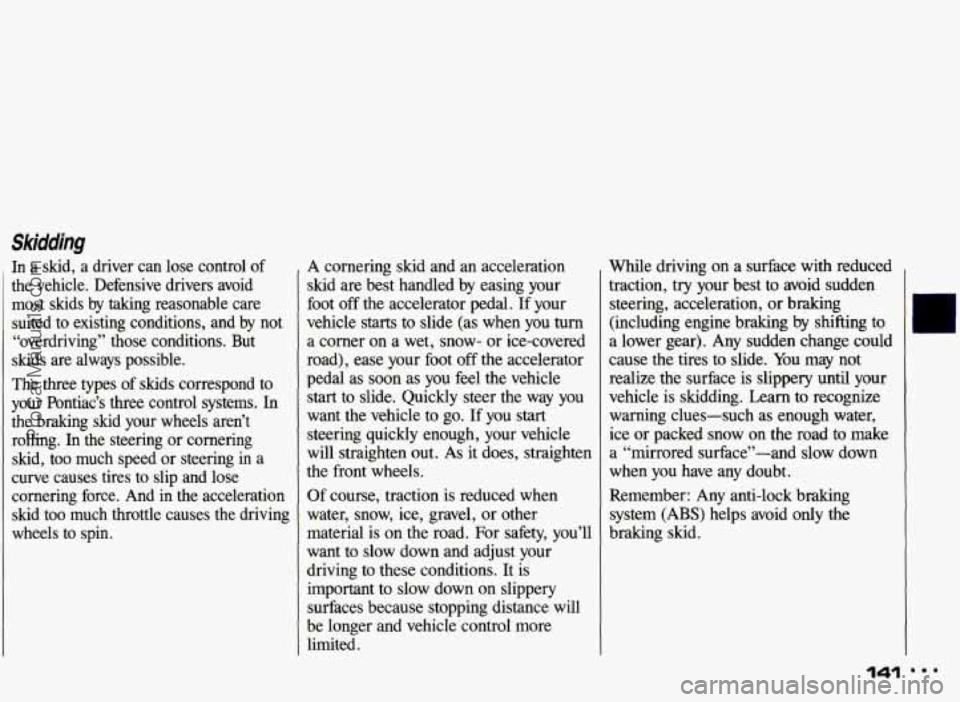
Skidding
In a skid, a driver can lose control of
the vehicle. Defensive drivers avoid
most skids by taking reasonable care
suited to existing conditions, and by not
“overdriving” those conditions. But
skids are always possible.
The three types of skids correspond to
your Pontiac’s three control systems.
In
the braking skid your wheels aren’t
rolling.
In the steering or cornering
skid, too much speed or steering in a
curve causes tires to slip and lose cornering force. And in the acceleration
skid too much throttle causes the driving
wheels to spin. A
cornering skid and an acceleration
skid are best handled by easing your
foot
off the accelerator pedal. If your
vehicle starts to slide (as when you turn
a corner on a wet, snow- or ice-covered
road), ease your foot off the accelerator
pedal as soon as you feel the vehicle
start to slide. Quickly steer the way you
want the vehicle to go.
If you start
steering quickly enough, your vehicle
will straighten out. As it does, straighten
the front wheels.
Of course, traction is reduced when
water, snow, ice, gravel, or other
material is on the road. For safety, you’ll
want to slow down and adjust your
driving to these conditions. It is
important to slow down on slippery surfaces because stopping distance will
be longer and vehicle control more
limited. While driving on
a surface with reduced
traction, try your best to avoid sudden
steering, acceleration, or braking
(including engine braking by shifting to
a lower gear). Any sudden change could
cause the tires to slide.
You may not
realize the surface is slippery until your
vehicle is skidding. Learn to recognize
warning clues-such as enough water,
ice or packed snow
on the road to make
a “mirrored surface”-and slow down
when you have any doubt.
Remember: Any anti-lock braking
system
(ABS) helps avoid only the
braking skid.
141
ProCarManuals.com
Page 176 of 306
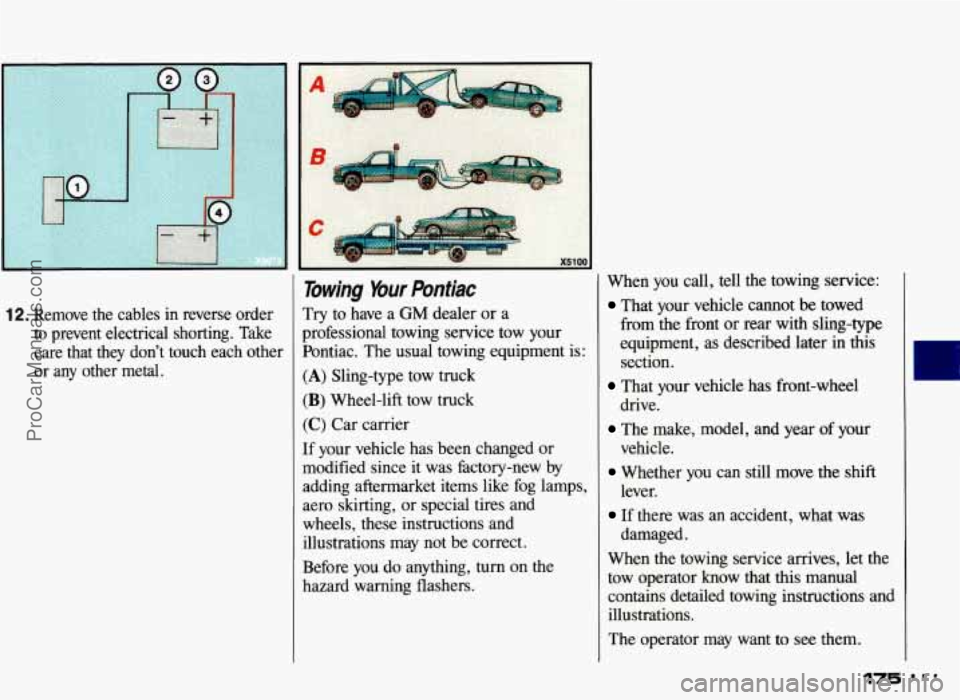
12. Remove the cables in reverse order
to prevent electrical shorting. Take
care that they don't touch each other
or any other metal.
lowing %ur Pontiac
Try to have a GM dealer or a
professional towing service tow your
Pontiac. The usual towing equipment is:
(A) Sling-type tow truck
(B) Wheel-lift tow truck
(C) Car carrier
If your vehicle has been changed or
modified since it was hctory-new
by
adding aftermarket items like fog lamps,
aero
skirting, or special tires and
wheels, these instructions and illustrations may not be correct.
Before you do anything,
turn on the
hazard warning flashers. When
you call,
tell the towing service:
That your vehicle cannot be towed
fram the front or rear with sling-type
equipment, as described later
in this
section.
drive. vehicle.
lever. damaged.
That your vehicle has front-wheel
The make, model, and year of your
Whether you can still move the shift
If there was an accident, what was
When the towing service arrives, let the
tow operator know that
this manual
contains detailed towing instructions and
illustrations.
The operator may want to
see them.
175 I..
ProCarManuals.com
Page 231 of 306

Service & Appearance Care
Windshield Wiper Blade
Replacement
Replacement blades come in different
types and are removed in different ways.
Here’s how to remove the type with a
release clip:
1 . Pull the windshield wiper arm away
2. Lift the release clip with a
from the windshield.
screwdriver and pull the blade
assembly off the wiper arm.
the wiper arm.
3. Push the new wiper blade securely on
Loading bur Vehicle
Two labels on your vehicle show how
much weight it may properly carry. The
Tire-Loading Information label found on
the rear edge of the driver’s door tells
you the proper size, speed rating and recommended inflation pressures for the
tires on your vehicle. It also gives
you
important information about the number
of people that can be in your vehicle and
the total weight that you can carry. This
weight is called the Vehicle Capacity
Weight and includes the weight of all
occupants, cargo, and all nonfactory- installed options. The other label is the Certification
sticker, also on the rear edge of the
driver’s door. It
tells you the gross
weight capacity of your vehicle, called
the GVWR (Gross Vehicle Weight
Rating). The GVWR includes the
weight of the vehicle, all occupants, fuel
and cargo. Never exceed the GVWR for
your vehicle, or the Gross Axle Weight Rating (GAWR) for either the front or
rear axle.
And, if you do have a heavy load, you
should spread it out. Don’t carry more
than
132 lbs. (60 kg) in your trunk.
ProCarManuals.com
Page 234 of 306
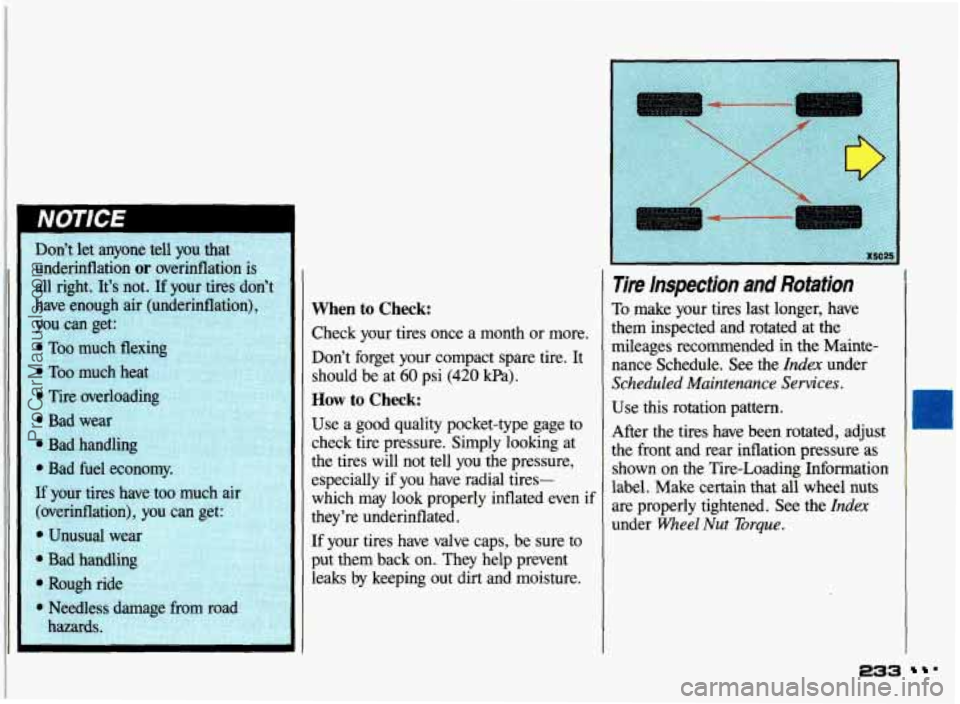
When to Check:
Check your tires once a month or more.
Don’t forget your compact spare tire. It
should be at
60 psi (420 kPa).
How to Check:
Use a good quality pocket-type gage to
check tire pressure. Simply looking at
the tires will not tell you the pressure,
especially if you have radial tires-
which may look properly inflated even if
they’re underinflated.
If your tires have valve caps, be sure to
put them back on. They help prevent
leaks by keeping out dirt and moisture.
lire inspection and Rotation
To make your tires last longer, have
them inspected and rotated at the
mileages recommended
in the Mainte-
nance Schedule. See the
Index under
Scheduled Maintenance Sewices .
Use this rotation pattern.
After the tires have been rotated, adjust
the front and rear inflation pressure as
shown
on the Tire-Loading Infomation
label. Make certain that all wheel
nuts
are properly tightened. See the Index
under Wheel Nut Torque.
233 .
ProCarManuals.com
Page 235 of 306

Service & Appearance Care
Tire Inspection and Rotation
(CONT)
1 Rust or dirt on a wheel, or on
- b the. parts to which it is
htened, ean fnake wheel nuts I
become loose after a time, The
wheel could come off and cause an I accident. When you change a
wheel, remove any rust or dirt
from plks where the wheel
When lt’s Time for New Tires
One way to tell when it’s time for new
tires is to check the treadwear
indicators, which will appear when your
tires have only
2/32 inch (1.6 mm) or
less of tread remaining.
You need a new tire if:
You can see the indicators at three
You can see cord or fabric showing
The tread or sidewall is cracked. cut.
places around the tire.
through the tire’s rubber.
attaches to the vehicle. ~n an 7 -
emergency, you can use a cloth or I I or snagged deep enough to show cord
a ppr towel ta do this; but be or fabric.
sure t.a use a scraper or wire brush The tire has a bump, bulge or split.
later, if you need to, to get all the The tire has a puncture, cut, or other
rust or dirt off, (See the Index damage that can’t be repaired well
undkr hgiing a 2?i?af Ere.) because of the size or location of the
I damage.
... 234
Buying New Tires
To find out what kind and size of tires
you need, look at the Tire-Loading
Information label.
The tires installed on your vehicle when
it was new had a Tire Performance
Criteria Specification (TPC Spec)
number on each tire’s sidewall. When
you get new tires, get ones with that
same TPC Spec number. That way, your
vehicle will continue to have tires that
are designed to give proper endurance,
handling, speed rating, traction, ride and other things during normal service
on your vehicle.
If your tires have an all-
season tread design, the TPC number
will be followed by a
“MS” (for mud
and snow).
If you ever replace your tires with those
not having a TPC Spec number, make
sure they are the same size, load range,
speed rating and construction type (bias,
bias-belted
or radial) as your original
I tires.
ProCarManuals.com
Page 236 of 306
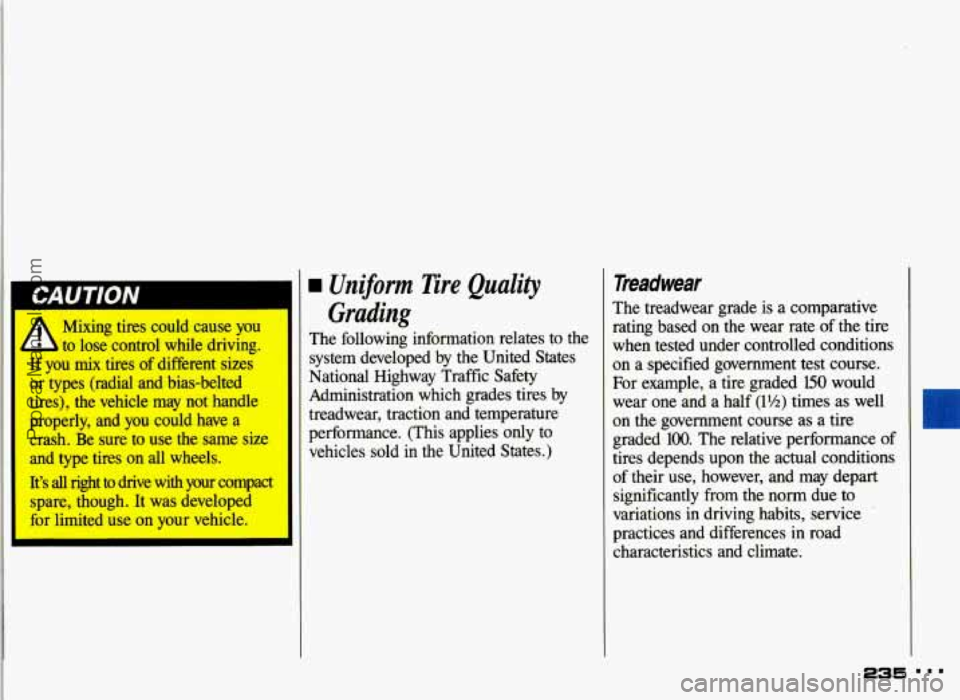
CAUTION
A
Mixing tires could cause you
to lose control while driving.
If you mix tires of different sizes
or types (radial and bias-belted
tires), the vehicle may not handle
properly, and you could have a
crash. Be sure to use the same size
and type tires on all wheels.
It's
all right to drive with your compact
spare, though. It was developed
for limited use
on your vehicle.
I
Grding
The following information relates to the
system developed by the United States
National Highway Traffic Safety
Administration which grades tires by
treadwear, traction and temperature
performance. (This applies only to vehicles sold in the United States.)
Treadwear
The treadwear grade is a comparative
rating based on the wear rate of the tire
when tested under controlled conditions
on a specified government test course.
For example, a tire graded
150 would
wear one and a half
(1%) times as well
on the government course as a tire
graded
100. The relative performance of
tires depends upon the actual conditions of their use, however, and may depart
significantly from the norm due to
variations in driving habits, service
practices and differences in road
characteristics and climate.
235 " '
ProCarManuals.com
Page 237 of 306
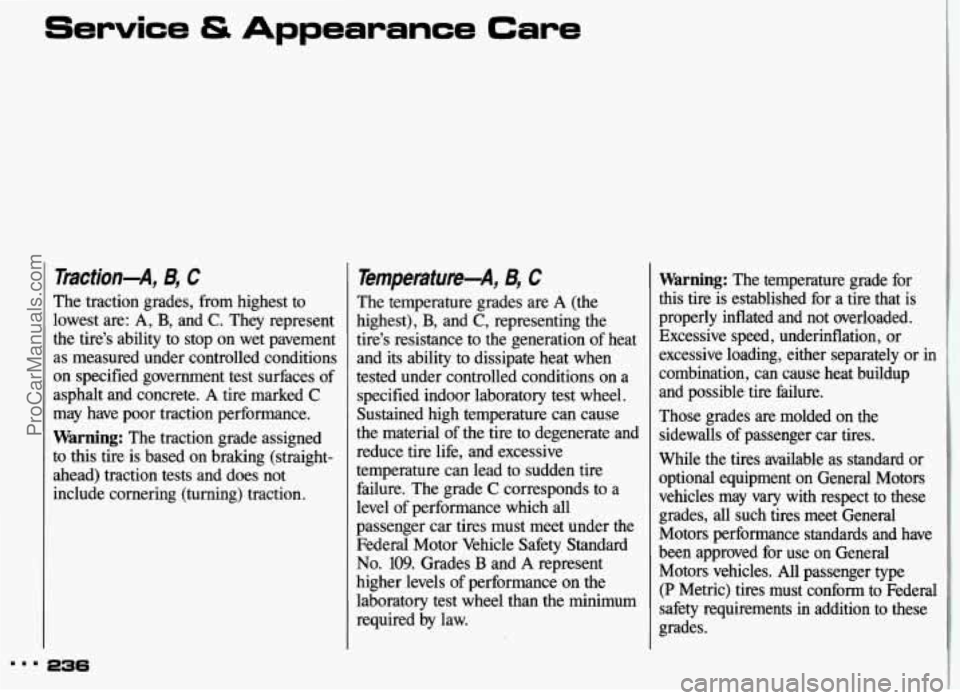
Traction-A, B, C
The traction grades, from highest to
lowest are:
A, B, and C. They represent
the tire’s ability to stop on wet pavement
as measured under controlled conditions
on specified government test surfaces of
asphalt and concrete.
A tire marked C
may have poor traction performance.
Warning: The traction grade assigned
to this tire is based on braking (straight-
ahead) traction tests and does not
include cornering (turning) traction.
Temperature-A, B, C
The temperature grades are A (the
highest),
B, and C, representing the
tire’s resistance to the generation of heat
and its ability to dissipate heat when
tested under controlled conditions on a
specified indoor laboratory test wheel.
Sustained high temperature can cause
the material of the tire to degenerate and
reduce tire life, and excessive
temperature can lead to sudden tire
failure. The grade
C corresponds to a
level of performance which all
passenger car tires must meet under the
Federal Motor Vehicle Safety Standard
No. 109. Grades B and A represent
higher levels of performance on the
laboratory test wheel than the minimum required by law.
Warning: The temperature grade for
this tire is established for a tire that is
properly inflated and not overloaded. Excessive speed, underinflation, or
excessive loading, either separately or in
combination, can cause heat buildup
and possible tire failure.
Those grades are molded on the sidewalls of passenger car tires.
While the tires available as standard or
optional equipment on General Motors
vehicles may vary with respect to these
grades,
all such tires meet General
Motors performance standards and have
been approved for use on General Motors vehicles. All passenger type
(P Metric) tires must conform to Federal
safety requirements in addition to these
grades.
ProCarManuals.com
Page 239 of 306
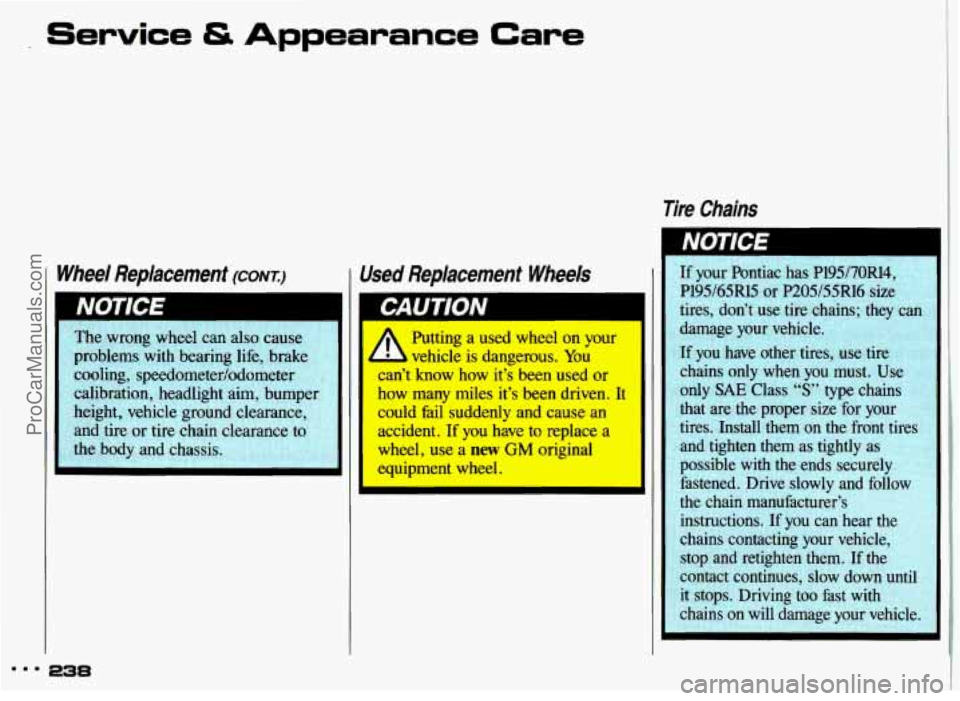
Service & Appearance Care
Tire Chains
...
Wheel Replacement (CONT.)
The wrong wheel can also cause
problems with bearing life, brake cooling, speedometer/odometer
calibration, headlight aim, bumper
height, vehicle ground clearance,
and tire or tire chain clearance to
the body and chassis.
I
238
Used Replacement Wheels
Putting a used wheel on your
L vehicle is dangerous. You
I cs know how it’s been used or
how many miles it’s been driven. It
-mid fail suddenly and cause an
accident. If you have
to replace a
\wheel, use a
new GM original If your Pontiac has P195/70R14,
P195/65R15
or P205/55R16 size
tires, don’t use tire chains; they can
damage your vehicle.
If you have other tires, use tire
chains only when you must. Use
only
SAE Class “S” type chains
that are
the proper size for your
tires. Install them
on the front tires
and tighten them as tightly as
possible with the ends securely fastened. Drive slowlv and follow
r’
the chain manufacturer’s
instructions. If you can
h
chains contacting your v
stop and retighten them. If the
contact continues, slow down until
it stops. Driving too fast with
chains on will damage your vehicle.
ProCarManuals.com